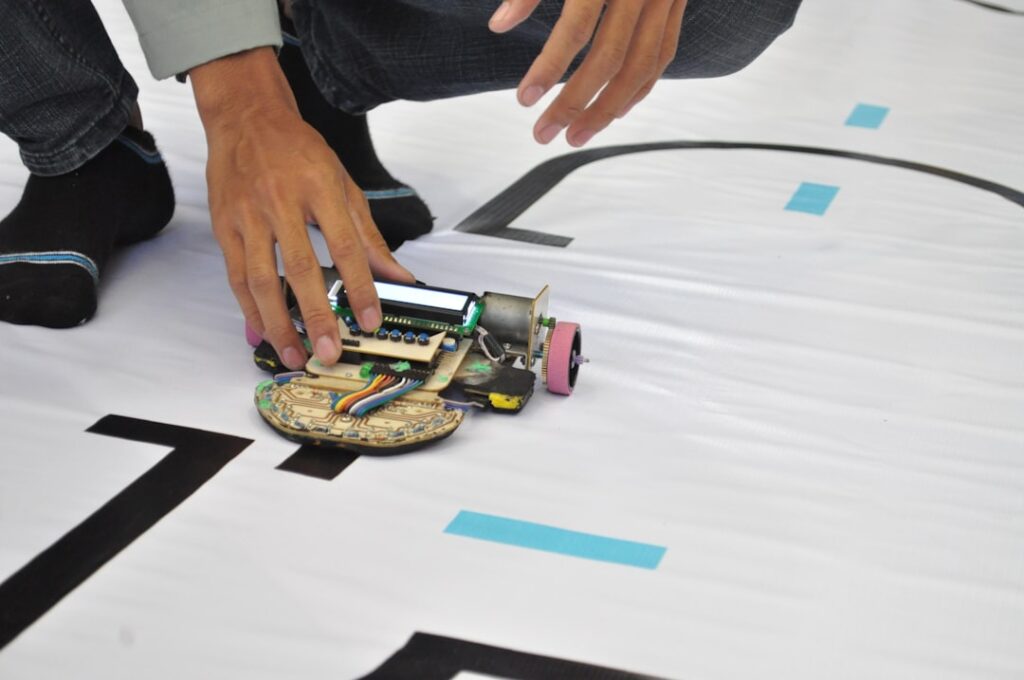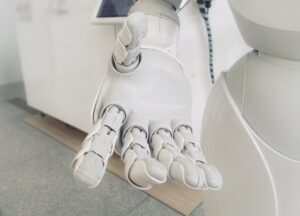Elon Musk, the visionary entrepreneur behind companies like Tesla and SpaceX, has long been an advocate for advancing human-robot interaction. Musk envisions a future where humans and robots work together seamlessly, with robots taking on tasks that are dangerous or repetitive, while humans focus on more complex and creative endeavors. This vision is not only exciting but also crucial for the advancement of technology in various industries. Human-robot interaction has the potential to revolutionize manufacturing, healthcare, education, and many other sectors, leading to increased efficiency, productivity, and overall progress.
Key Takeaways
- Elon Musk envisions a future where humans and robots interact seamlessly.
- Advancing human-robot interaction is crucial for improving efficiency and safety in various industries.
- Tesla is at the forefront of revolutionizing human-robot interaction through its autonomous driving technology.
- Challenges in human-robot interaction include safety concerns, ethical considerations, and the need for effective communication.
- The future of human-robot interaction includes more advanced AI, increased collaboration, and potential benefits for healthcare and education.
The Importance of Advancing Human-Robot Interaction
Human-robot interaction holds immense benefits across various industries. In manufacturing, for example, robots can perform repetitive tasks with precision and speed, leading to increased efficiency and reduced costs. They can also handle dangerous tasks that may pose a risk to human workers. This not only improves safety but also allows humans to focus on more complex and creative aspects of production.
In healthcare, robots can assist with surgeries, perform routine tasks like taking vitals or delivering medication, and even provide companionship to patients. This can improve patient outcomes, reduce the workload on healthcare professionals, and increase access to care in underserved areas.
In education, robots can act as tutors or teaching assistants, providing personalized instruction and support to students. They can also help bridge the gap in access to education by reaching remote or disadvantaged communities. By freeing up teachers’ time from administrative tasks, robots can enable educators to focus on individualized instruction and mentorship.
Tesla’s Role in Revolutionizing Human-Robot Interaction
Tesla, under Elon Musk’s leadership, has been at the forefront of revolutionizing human-robot interaction. The company has made significant advancements in automation and robotics in its manufacturing processes. Tesla’s Gigafactories utilize a high degree of automation, with robots performing tasks like welding, painting, and assembly.
One notable example is Tesla’s use of the “Giga Press” machine, which is a massive casting machine that can produce large structural components for electric vehicles. This machine is operated by robots and has significantly increased the efficiency and speed of production. By automating these processes, Tesla has been able to scale up production and meet the growing demand for electric vehicles.
The Challenges of Human-Robot Interaction and How to Overcome Them
While the potential benefits of human-robot interaction are vast, there are also challenges that need to be addressed. Safety concerns and regulations are one of the primary challenges. As robots become more integrated into various industries, ensuring their safety and preventing accidents becomes crucial. Strict regulations and standards need to be in place to govern the design, operation, and maintenance of robots.
Ethical considerations also come into play when it comes to human-robot interaction. Questions arise about the impact on employment, privacy, and the potential for robots to replace human interaction in certain domains. It is essential to strike a balance between the benefits of automation and the preservation of human dignity and well-being.
Collaboration between humans and robots is another challenge that needs to be addressed. As robots become more capable, it is crucial to design systems that allow for effective collaboration between humans and robots. This includes developing intuitive interfaces, communication protocols, and training programs that enable humans to work alongside robots seamlessly.
The Future of Human-Robot Interaction: What to Expect
The future of human-robot interaction holds exciting possibilities. Advancements in robotics, artificial intelligence (AI), and machine learning are expected to lead to more sophisticated and capable robots. These robots will be able to perform complex tasks with greater autonomy, adaptability, and intelligence.
Predictions for advancements in human-robot interaction include the development of humanoid robots that can mimic human movements and expressions, as well as robots with enhanced sensory capabilities that can perceive and interact with their environment more effectively. Additionally, AI will play a crucial role in improving the capabilities of robots, enabling them to learn from experience, make decisions, and adapt to changing circumstances.
In terms of integration into daily life, robots are expected to become more prevalent in various domains. From household chores to customer service, robots will increasingly take on tasks that were traditionally performed by humans. This will free up human time and energy for more meaningful and creative pursuits.
The Impact of Human-Robot Interaction on Society and the Economy

The increasing integration of robots into various industries will undoubtedly have an impact on society and the economy. One potential concern is job displacement. As robots take over repetitive and routine tasks, there is a risk of job loss for certain sectors. However, it is important to note that human-robot interaction also has the potential to create new jobs and opportunities. The development, maintenance, and operation of robots will require skilled workers, leading to the emergence of new industries and job roles.
Furthermore, increased efficiency and productivity resulting from human-robot interaction can have significant economic benefits. By automating tasks, companies can reduce costs, improve product quality, and increase output. This can lead to economic growth, job creation, and improved living standards.
The Ethical Implications of Human-Robot Interaction
As human-robot interaction becomes more prevalent, it is crucial to consider the ethical implications. One key consideration is the impact on employment. While automation can lead to increased efficiency and productivity, it can also result in job displacement for certain sectors. It is important to ensure that appropriate measures are in place to support workers who may be affected by automation, such as retraining programs or income support.
Privacy is another ethical concern when it comes to human-robot interaction. As robots become more integrated into our daily lives, they may collect and store personal data. It is essential to establish clear guidelines and regulations regarding data privacy and security to protect individuals’ rights and prevent misuse of personal information.
Additionally, the potential for robots to replace human interaction raises questions about the preservation of human dignity and well-being. While robots can provide valuable assistance and support, it is important to ensure that they do not replace genuine human connection and empathy. Striking a balance between automation and human interaction is crucial for maintaining the social fabric of society.
The Role of Artificial Intelligence in Human-Robot Interaction
Artificial intelligence (AI) plays a crucial role in advancing human-robot interaction. AI enables robots to learn from experience, make decisions, and adapt to changing circumstances. Machine learning algorithms allow robots to analyze data, recognize patterns, and improve their performance over time.
AI also enables robots to understand and respond to human commands and gestures, making human-robot interaction more intuitive and natural. Natural language processing algorithms allow robots to understand and generate human language, facilitating communication between humans and robots.
Furthermore, AI can enhance the capabilities of robots by enabling them to process and interpret sensory information more effectively. This allows robots to perceive and interact with their environment in a more sophisticated manner, leading to improved performance and adaptability.
The Potential of Human-Robot Interaction to Improve Healthcare and Education
Human-robot interaction has immense potential to improve healthcare and education. In healthcare, robots can assist with surgeries, perform routine tasks like taking vitals or delivering medication, and even provide companionship to patients. This can improve patient outcomes, reduce the workload on healthcare professionals, and increase access to care in underserved areas.
In education, robots can act as tutors or teaching assistants, providing personalized instruction and support to students. They can adapt their teaching methods based on individual learning styles and pace, ensuring that each student receives tailored instruction. Robots can also help bridge the gap in access to education by reaching remote or disadvantaged communities that may not have access to qualified teachers.
The Importance of Investing in Human-Robot Interaction Research and Development
In conclusion, human-robot interaction holds immense potential for advancing technology and improving various industries. From manufacturing to healthcare and education, robots can enhance efficiency, productivity, and overall progress. However, there are challenges that need to be addressed, including safety concerns, ethical considerations, and the need for effective collaboration between humans and robots.
Investing in research and development is crucial to overcome these challenges and unlock the full potential of human-robot interaction. Continued advancements in robotics, AI, and machine learning will lead to more sophisticated and capable robots that can perform complex tasks with greater autonomy and adaptability. By investing in human-robot interaction, we can create a future where humans and robots work together seamlessly, leading to a more efficient, productive, and innovative society.
If you’re fascinated by Elon Musk’s ventures in robotics, you might also be interested in exploring the article “Sell Me This Pen: The Art of Persuasion in Sales” on AITV Media. This insightful piece delves into the strategies and techniques used by successful salespeople to sell everyday objects, including pens. Discover how the power of persuasion can be applied not only to selling products but also to shaping the future of robotics and technology. Check out the article here.



